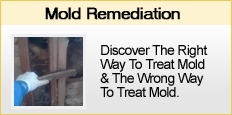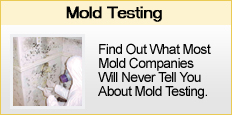Red Flags – What To Look For?
 |
 |
 |
Red Flags For Mold – What Should You Look For?
When is it time to have the problem assessed by our trained inspectors?
Sometimes the naked eye and our nose can be tricked into believing what is truly mold or something completely different. What our trained inspectors look for is what we call a “Red Flags.”
Identifying Red Flags can be difficult for the average homeowner but not for inspectors who go into hundreds of homes each month. A red flag would be any situation, condition, or cause that is favorable for mold growth. This could be visible mold, areas where there has been history or recent water intrusion, or where the inspector senses “musty” odors, and/or an occupant states they have mold related symptoms.
Some “Red Flags” are common sense like in conditions where moisture and water damage has occurred. This more likely then not will cause mold amplification in a short period and must be addressed ASAP to prevent compromising indoor air quality. If visible discoloration appears on building material, clothes, personal belongings, etc, it could be mold growth. And yes, mold does not always appear black. Different types of mold will literally give off a different color (any color of the rainbow for that matter) on different substrates.
Relying on our human senses is another “Red Flag.” Do you smell something unusual? Do the surfaces feel cool or damp and is the home cleaned on a daily basis? Homes that are not cleaned daily will build up dust. Dust is a perfect nutrient for mold and mold will begin to feed on dust where it has settled.
An extremely important “Red Flag” is you and your family’s overall well-being. We meet with hundred of homeowners every year that exhibit symptoms of mold exposure. There are over 200 medically associated illnesses to indoor mold. Pregnant women, immune-compromised individuals, children (because there lungs are maturing and tend to have weaker immune systems), and basically anyone can have a reaction to mold. One of our healthy, seasoned inspectors developed a significant reaction to mold after continued exposure. Remember, if there is a lot of mold present (it is not always visible) you could have a reaction from short-term exposure. If there are traces of elevated mold, it may take longer to exhibit reactions. However, some individuals may be hyper-sensitive. We often meet families where one family member is extremely ill while the other members are perfectly healthy. NO INDIVIDUAL IS ALIKE, NO MOLD IS ALIKE, SO YOUR EXPOSURE AND REACTION WILL NOT BE ALIKE. However, it is likely that if mold and moisture problems go unresolved, you’re rolling the dice with you and your family’s health (and possibly the integrity of your home).
The final “Red Flag’ is BUILDING SCIENCES. This basically is the make-up of your home. Our trained inspectors use the latest techniques in discovering the primary factors contributing to mold proliferation.
These are:
1.) Water
2.) Temperature
3.) Nutrient availability.
These factors also impact the types of species found and the fungal community structure.
Don’t ever try to correct moisture or mold problem unless you are fully aware of the risks you could be taking. There is ABSOLUTEY no fee to have our trained inspectors educate you on what the 1st step should be and whether its something you can handle on your own.

